This article was co-authored by wikiHow Staff. Our trained team of editors and researchers validate articles for accuracy and comprehensiveness. wikiHow's Content Management Team carefully monitors the work from our editorial staff to ensure that each article is backed by trusted research and meets our high quality standards.
wikiHow marks an article as reader-approved once it receives enough positive feedback. This article received 11 testimonials and 94% of readers who voted found it helpful, earning it our reader-approved status.
This article has been viewed 605,084 times.
Learn more...
Saunas are a great way to unwind, relax, and warm up during cold weather. They are also a great chance to relax socially. Among many reputed health benefits, saunas are thought to be able to relieve pain, improve performance in sports, temporarily relieve cold symptoms, and reduce stress. Like many good things, however, it's important to use a sauna in moderation.
Steps
Taking Proper Precautions
-
1Be in good health and avoid saunas if you have any high-risk medical conditions. Saunas are considered safe for most users, but some people need to take extra precautions. Others might have to avoid saunas altogether. If you are taking medications, or have any medical conditions, ask your doctor for advice. Some illnesses, such as a cold, might benefit from a short visit. Others might get worse. You should reconsider using a sauna if:
- You have unstable angina pectoris, poor blood pressure, abnormal heart beats, advanced heart failure, recent myocardial infarction, or severe aortic stenosis.
- You have other high-risk medical conditions, such as: kidney disease, liver failure, or other cardiac conditions.[1]
- You are a child, pregnant, or trying to conceive. Many places won't allow children under a certain age to use the sauna. Saunas may also affect the developing fetus, or reduce sperm count.
- You are feeling sick, faint easily, have cramps, suffering from heat exhaustion or heat stroke.
- You are taking medications that prevent you from sweating or cause you to overheat very quickly.
-
2Drink two to four glasses of water before going into a sauna. Saunas cause the body to sweat, and thus lose water. Because of this, is vital that you stay hydrated. If you don't drink enough water before getting in, you can get dehydrated. This can lead to heat strokes, or worse. Water is the best, but isotonic drinks are also suitable.Advertisement
-
3Bring a clean, cotton towel to sit on. This will help keep you clean, as well as protect the benches from body oils. If you are going into a coed sauna, consider bringing a cotton sarong or wrap to cover yourself with. Whatever you bring into the sauna must be dry and clean.
- Ideally, you should clean your sauna attire using water, and if needed, a little bit of white vinegar. A mild detergent intended for baby clothes is also a good substitute.
-
4Do not wear anything dirty or tight-fitting to a sauna, including things that you wore throughout the day. Clothes pick up lots of dust and dirt throughout the day. The sauna's heat will loosen this dirt, and release it into the air and onto your skin. You also should not wear tight-fitting clothes, as your skin also needs to breathe. Listed below are things that are not appropriate to bring into a sauna:
- Clothes you wore throughout the day are bad for saunas.
- Shoes are bad choices for the same reason as your day clothes. Shower sandals are okay to wear to the sauna, but should be taken off once you get inside, especially before you get up on the benches.
- Sweat suits and workout clothes are bad choices, especially if you just wore them to a workout.
- Sauna suits made out of PVC are dangerous. They keep the skin from breathing, and can actually melt in the sauna. The high temperatures will cause them to give off toxic fumes, chemicals, and residue.
- Old, loose-fitting swimsuits are okay, so long as they are colorfast, and contain no slimming panels or metal parts.
- Anything that has metal on it. Saunas get hot, and metal heats up easily. If that metal is against your skin, you could end up with bad burns.
-
5Skip on the creams, lotions, and jewelry. Metal heats up fast in saunas, so while you might go in looking fashionable, you'll leave with painful burns. If you have any jewelry, take it off, and put it in a safe place. Do not take it into the sauna with you.[3] You also don't want to wear any creams or lotions. If they don't run with your sweat and make an oily mess, they will clog up your pores and keep your skin from breathing and sweating.
-
6Be well-rested and don't go in after a big meal. If you just ate, wait one to two hours before heading into the sauna. This is because your body will be using a lot of energy to digest and process that food. If you just finished working out, wait until your heart rate slows down and you regain some energy. Your body will need this energy in the sauna.
Staying Safe Inside
-
1Bring a friend with you. Not only can a friend help you feel more relaxed, but they can help you if something goes wrong. If you go into a sauna alone and pass out, no one will be there to help you. A friend can help you in such a situation, and get you to safety.[4]
-
2Read the instructions to the sauna that you're using. Each sauna will have slightly different instructions, so it is best to review them and not make assumptions. Most saunas will carry their own, specific health guidelines and warnings. If you are going to a public sauna, the instructions will be posted on the wall. If you don't see any instructions, ask the person in charge of caring for the sauna for more information.
-
3Use a lower temperature, especially if you are new to using saunas.[5] The maximum allowed temperature in Canada and the United States is 194°F (90°C).[6] Some European countries allow much higher temperatures, which can be unsafe, especially after longer periods of time.
- If the temperature feels too hot, ask that it be turned down, or keep out.
-
4Limit your experience to 15 to 20 minutes at the most. It's okay to get out sooner if you start to feel uncomfortable. The human body is not made to withstand such high temperatures for long periods of time.
-
5Get out immediately if you start to feel dizzy, nauseous, or lightheaded. Don't try to suck it up and deal with it, or stick it out. Proving your endurance is not worth passing out in a sauna, which can be very dangerous.[7] Headaches, nausea, dizziness, and lightheadedness are all signs that something is not right. You should take these signs your body is giving you very seriously, and get out.
Establishing a Post-Sauna Routine
-
1Cool down slowly after the sauna. Some people like to have a warm shower before getting dressed after a sauna. Other people like to jump into a cold pool or shower right afterwards to stimulate their body. While this can be invigorating, it can send your body into shock, and it not a good idea, especially for those with heart problems.
-
2Rest for at least ten minutes after getting out of a sauna. Don't jump straight to your next work out.[8] Instead, find a cool place where you can sit still or lay down. This will give your body some time to recuperate and your heart rate to slow down.
-
3Follow up with a shower, but skip on the soap. Start off using warm water. Once the sweat is all gone, lower the temperature to a pleasantly cool one. This will help your body cool down further.
- If you must use soap, go for a mild, natural soap. Saunas cause your pores to open up, and harsh soaps can irritate your skin.
-
4Drink two to four glasses of water after getting out of the sauna.[9] Your body loses a lot of water through sweating, so you will need to replenish that water quickly.
-
5Consider eating a salty snack after leaving the sauna. This is especially important if you happen to sweat a lot.[10] Pretzels or salty crackers would be ideal, so long as they don't contain too many fats. These salty snacks will help restore any sodium you lost in the sauna. Other foods that are good post-sauna (that go well with pretzels or salty crackers) include:[11]
- Cheese, which will restore protein.
- Fresh fruits, such as apples, which will restore any vitamins and fiber.
-
6Keep your sauna clean to prevent the buildup and spread of bacteria. If you have a personal sauna and use it regularly, you'll want to clean it once a week using a natural cleaning product, such as vinegar. Never use anything with chemicals. Here is what you should do:
- Vacuum the sauna to get rid of dust, hair, and dead skin cells.
- Wipe down the benches and backrests with diluted white vinegar. This will disinfect the sauna.
- Use baking soda on stubborn stains, especially oil-based ones.
Community Q&A
-
QuestionWhat is a recommended age for children in a sauna?
 Community AnswerI'm from Finland and I can tell you there isn't really any recommendation of age for children. I wouldn't bring a baby to sauna, but after the age of 3, it should be fine. Just make sure your child gets out if he or she is feeling poorly, and that he or she stays away from the coal (if that is the type of sauna to which you are going).
Community AnswerI'm from Finland and I can tell you there isn't really any recommendation of age for children. I wouldn't bring a baby to sauna, but after the age of 3, it should be fine. Just make sure your child gets out if he or she is feeling poorly, and that he or she stays away from the coal (if that is the type of sauna to which you are going). -
QuestionWhat is the best temperature for a sauna?
 Community AnswerThat isn't an easy question to answer. Each and every person handles temperatures differently. The best advice is to not push your body any more than it can handle. The general legal maximum in the US (and Imost parts of europe) is 90ºC. Experiment with your sauna's temperature, starting from a lower temperature and increasing it depending on how you handle the temperature. Just remember not to push it or stay in for too long, or you'll just end up doing yourself more harm than good in both the short and long term!
Community AnswerThat isn't an easy question to answer. Each and every person handles temperatures differently. The best advice is to not push your body any more than it can handle. The general legal maximum in the US (and Imost parts of europe) is 90ºC. Experiment with your sauna's temperature, starting from a lower temperature and increasing it depending on how you handle the temperature. Just remember not to push it or stay in for too long, or you'll just end up doing yourself more harm than good in both the short and long term! -
QuestionWhat is a bucket of water inside of a sauna for?
 Community AnswerThere should also be a ladle near it, which is used to throw some löyly. Löyly means throwing water on the stones on the stove, generating steam that spreads the heat around the sauna. The steam also makes the hot air easier to breath, so it is advisable to throw even a little bit of löyly even though it makes the sauna feel a bit warmer every time. If you are in a true Finnish sauna, the water can also be used to wet the vihta (also known as a birch whisk) to make it softer.
Community AnswerThere should also be a ladle near it, which is used to throw some löyly. Löyly means throwing water on the stones on the stove, generating steam that spreads the heat around the sauna. The steam also makes the hot air easier to breath, so it is advisable to throw even a little bit of löyly even though it makes the sauna feel a bit warmer every time. If you are in a true Finnish sauna, the water can also be used to wet the vihta (also known as a birch whisk) to make it softer.
Warnings
- Get out immediately if you start to feel sick or lightheaded. Do not try to stick it out.⧼thumbs_response⧽
- Be careful of anyone who claims unrealistic health benefits from overdoing the sauna.⧼thumbs_response⧽
Things You'll Need
- Towel
- Flip flops
References
- ↑ http://www.med.wisc.edu/news-events/sauna-induced-sweating-offers-many-health-benefits/30199
- ↑ http://wanderingcarol.com/how-to-spa/the-9-rules-of-sauna-safety/
- ↑ http://www.ebay.com/gds/8-Sauna-Safety-Tips-/10000000177632816/g.html
- ↑ http://wanderingcarol.com/how-to-spa/the-9-rules-of-sauna-safety/
- ↑ http://www.med.wisc.edu/news-events/sauna-induced-sweating-offers-many-health-benefits/30199
- ↑ http://www.sauna-talk.com/sauna-temperature.html
- ↑ http://wanderingcarol.com/how-to-spa/the-9-rules-of-sauna-safety/
- ↑ http://wanderingcarol.com/how-to-spa/the-9-rules-of-sauna-safety/
- ↑ http://www.thealternativedaily.com/5-sauna-rules-be-safe/
About This Article
To use a sauna safely, make sure to drink 3 glasses of water before you enter so that you don’t get dehydrated. You may also want to consider going with a friend so that they can help you in case you pass out or get sick. When you’re new to using saunas, set the temperature lower than the maximum of 194° F and limit your time inside to 15 minutes at the most. Additionally, remove any metal jewelry, since it can heat up in the sauna and burn your skin. If you get a headache or feel lightheaded, make sure to get out of the sauna right away to cool down. For tips on how to cool down safely after your time in a sauna, read on!


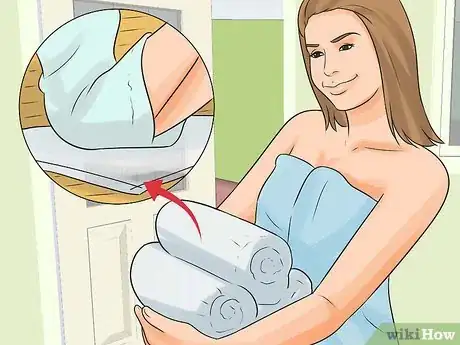

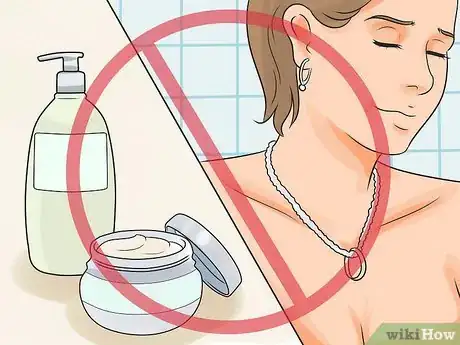



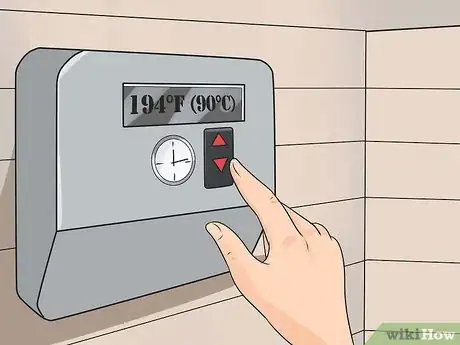
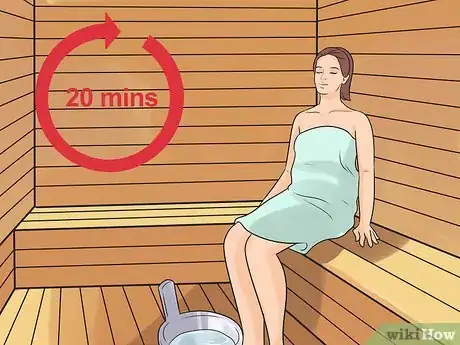



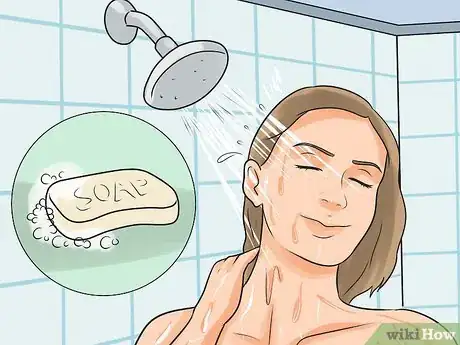

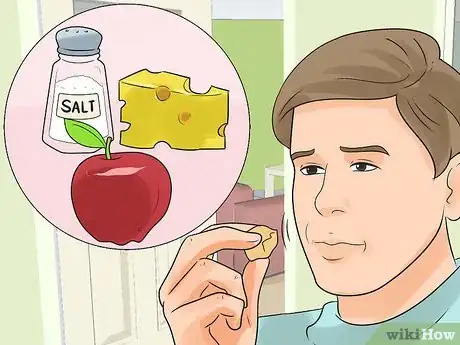
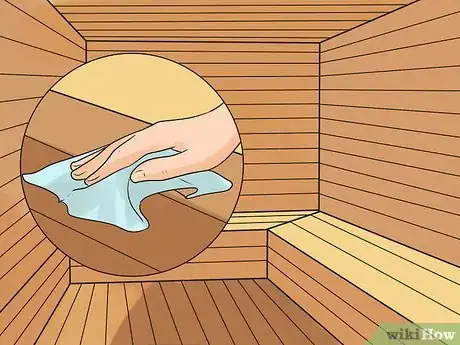












-Step-27-Version-2.webp)
















































